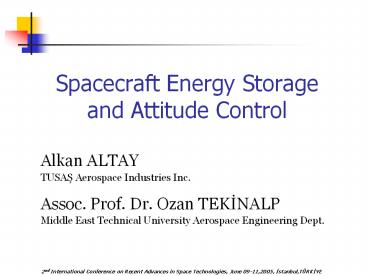Spacecraft Energy Storage and Attitude Control
Title:
Spacecraft Energy Storage and Attitude Control
Description:
Spacecraft Energy Storage and Attitude Control Alkan ALTAY Assoc. Prof. Dr. Ozan TEK NALP TUSA Aerospace Industries Inc. Middle East Technical University Aerospace ... –
Number of Views:190
Avg rating:3.0/5.0
Title: Spacecraft Energy Storage and Attitude Control
1
Spacecraft Energy Storage and Attitude Control
Alkan ALTAY Assoc. Prof. Dr. Ozan TEKINALP
- TUSAS Aerospace Industries Inc.
Middle East Technical University Aerospace
Engineering Dept.
2
Energy Storage in LEO Spacecrafts
3
Attitude Control in LEO Spacecrafts
4
Integrated Power and Attitude Control
5
IPACS - VSCMG
6
Conceptual Design Calculations
Small Spacecraft Requirements Small Spacecraft Requirements
Energy Storage ( Wh ) 100
Number of Charge/Discharge Cycles 30,000
Torque Capacity ( Nm ) 0.025
Angular Momentum Capacity (Nms ) 6
Number of Attitude Actuators 4
IPACS-VSCMG Design Parameters IPACS-VSCMG Design Parameters IPACS-VSCMG Design Parameters IPACS-VSCMG Design Parameters
FW1 FW2 FW3a
Max Wheel Speed (kRPM) 30 60 240
Angular Momentum Capacity (Nms) 15.3 7.7 1.9
Max Torque (Nm) 1.74 0.87 0.22
DoD 0.9375 0.9375 0.9375
Energy Density (Wh/kg) 5.0 8.3 25.0
a fails structurally a fails structurally a fails structurally a fails structurally
ElectroChemical Battery Parameters ElectroChemical Battery Parameters ElectroChemical Battery Parameters
Ni-Cd Li-Ion
Energy Density (Wh/kg) 35 110
Depth of Discharge 20 20
Reaction Wheel Design Parameters Reaction Wheel Design Parameters
MaxWheel Speed ( RPM ) 5000
Maximum Torque (Nm) 0.015
Angular Momentum Capacity ( Nms ) 3.4
CMG Design Parameters CMG Design Parameters
Operating Speed (RPM) 15000
Max. Gimbal Speed (rad/s) 0.1
Maximum Output Torque (Nm) 0.22
Angular Momentum Capacity (Nms) 1.9
7
Comparisons
Electric Power System Advantages Of IPACS
Uncoupled energy storage and power capacity
More Charge/Discharge Cycles
Long Life
High Charge/Discharge Rates
Deterministic State of Charge
Attitude Control System Advantages of IPACS
Large Control Torques
Large Momentum Storage
Low Vibration (for Magnetic Bearing)
8
Simulation of a S/C Equipped With IPACS
Spacecraft Inertias (kgm2) 15, 15, 10
Initial Orientation of S/C (deg) 0, 0, 0
Skew Angle, ß (deg) 54.73
IPACS-VSCMG FW2 (60 kRPM)
Initial Flywheel Spin Rates (kRPM) 35, 40, 45, 50
Initial Gimbal Angles (deg) 110, -125, 110, -125
60 deg of roll maneuver is expected from the
spacecraft while energy is being drawn from the
IPACS-VSCMGs
9
Simulation Results
- Smooth Maneuvering Capability
- Both Attitude and Power Objectives
Satisfied - - Uncoupled Power and Attitude Functions
10
Simulation Results
- We are able to follow any desired spin rate
profile - Low gimbal rates due to the high
angular momentum content
11
Future Work
The Solution To The Kinematic Singularity Problem
Application of Blended Inverse Building A
Prototype ?































